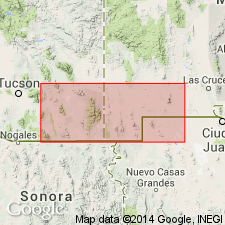
- Usage in publication:
-
- Bugle Member*
- Modifications:
-
- Named
- Dominant lithology:
-
- Limestone
- AAPG geologic province:
-
- Basin-and-Range province
- Pedregosa basin
Summary:
Named as lower member of Keating Formation of Escabrosa Group from Bugle Ridge shown on 1:62,500 scale Big Hatchet, NM quad map. Type section in E1/2 sec 30, T29S, R15W, Hidalgo Co, NM. Recognized in the Klondike Hills, Cedar Mountains, and Peloncillo Mountains, NM and the Chiricahua and Pedregosa Mountains, AZ in the Pedregosa basin and Basin-and-Range province. Formerly called member A of Keating Formation by Armstrong (1962). Consists of gray, massive-bedded, bryozoan-echinoderm to ooid packstone and wackestone and argillaceous crinoidal-bryozoan packstone with almost no chert. Fossils listed. 75 m thick at type section. Overlies Box Member of Percha Shale with sharp, unconformable contact. Overlain by Witch Member (new) of Keating Formation. Is late early to early middle Tournaisian (Early Mississippian) in age on basis of fossil brachiopods and foraminifers.
Source: GNU records (USGS DDS-6; Denver GNULEX).
For more information, please contact Nancy Stamm, Geologic Names Committee Secretary.
Asterisk (*) indicates published by U.S. Geological Survey authors.
"No current usage" (†) implies that a name has been abandoned or has fallen into disuse. Former usage and, if known, replacement name given in parentheses ( ).
Slash (/) indicates name conflicts with nomenclatural guidelines (CSN, 1933; ACSN, 1961, 1970; NACSN, 1983, 2005, 2021). May be explained within brackets ([ ]).

